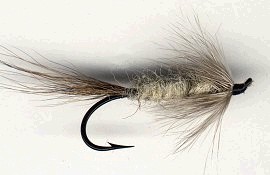
On The Fly
"Fly tying is a school from which we never graduate"
TYING NEWS
The Southern Oregon Fly Tiers met Wednesday, August 9th at the library in Gold Hill. There was a fly raffle and tying demonstrations by several talented members. We encourage novice and experienced tiers alike to drop by for a fun evening. A lot of valuable knowledge will be exchanged at no charge. Several members brought their fourteen flies to donate to the Casting for Recovery program coming up this fall. The next meeting will be on September 13th when we will resume the popular fly exchange. So join us the second Wednesday of each month for more fun and the sharing of the art.
 PATTERN OF THE MONTH - Burlap
PATTERN OF THE MONTH - Burlap
Hook: Standard salmon/steelhead size 4-10.
Thread: Gray or dark gray size 6/0.
Tail: Mottled deer hair.
Body: Strands of burlap, picked out.
Collar: Soft, long grizzly feather tied back slightly.
Head: Thread.
Tying Instructions:
1) Start the thread two eye-lengths behind the eye. This is your marker for
the collar tie-in point. Wind a thread base back to just above the barb of
the hook.
2) If this is a weighted fly, wind the lead wire on the hook shank and bind
down the wire.
3) Select a bunch of deer hair about 2/3 shank-length long and tie it in on
top of the hook. Do not wrap the hair so tight that it flairs.
4) Wrap the thread forward to the end of the eye loop. Tie in the burlap on
the side of the hook facing you to fill the gap created by the return. Tie
down the burlap the length of the hook to the tail. Next, wrap the thread
forward to marker.
5) Wrap the burlap forward in touching turns to the marker. Tie off and rough
up the burlap with your Velcro stick or bore cleaning brush.
6) Select a soft hackle feather long enough for the tips of the barbs to
reach the point of the hook. Wind the hackle several turns forward and tie it
off.
7) Tie back on the hackle to form a slant of 45 degrees. Form a small,
tapered head and apply cement.
The Burlap fly was developed by Arnold Arana in 1945 for
the Klamath River where it is still popular and used extensively today. The
pattern is a reliable producer and provides a good pattern for any of the
areas low, clear waters this time of year when fish become spooky. Steelhead
can only enter larger river systems open to the sea and characterized by
lower and stable water flows.
The rule of “dark day, dark fly and bright day, bright fly”
still applies but in a more subtle way with only slight changes in tail and
collar materials necessary. Hook sizes will vary depending on water levels
and fish size in different regions. For deeper runs and pools a larger more
heavily weighted fly can be drifted near the bottom. At times, steelhead will
not rise through a lot of water to pursue a “swing” fly. The real problem is
to put the fly in front of a fish that will bite. So presentation can be
critical. The Burlap is a simple pattern with only three ingredients, so tie
some up, give them a test flight and let me know how you did. I will have a
couple of half-dozen samples in the raffle so buy those tickets at the next
club meeting.
TYING TIPS
The possibility for variation with fishing success goes
beyond just size and color. Try using solid color hackle collars such as
browns, grays or olive. Matching hackle barbs work well for tailing, in fact
the original used natural grizzly. Burlap material is usually a uniform
thickness, so if you wish to create a tapered body, wrap an underbody of the
desired shape first. A popular variation from British Columbia is known as
the Sack Fly and substitutes a tail of bright-orange hackle feathers.
I encourage all tiers to donate a sample of your skill to
the Steelhead Tournament Fundraiser. It’s a great cause, worth the effort.
Tie One On,
Dan Kellogg (you can contact me at FLYGUY@EZNORTHWEST.COM)